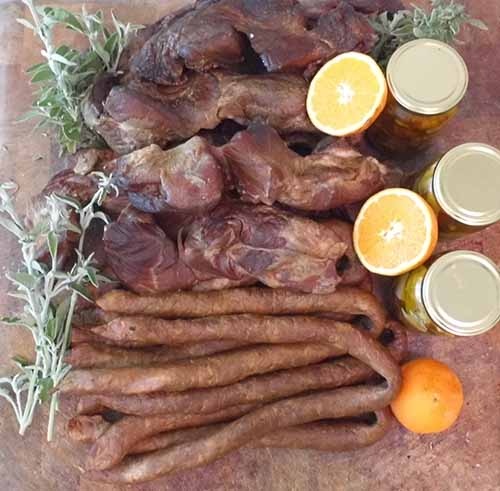People in Mani were able to preserve foods such as quail and pork using sea salt as the need for survival made them take advantage of everything nature had to offer.
Quail
Quail is typical prey in Mani. They arrive in the area in order to rest before their long journey to Africa. According to written records, quail has not only been a food source but also a strong export product to domestic and foreign markets since the 16th century. Women in Mani used to engage in quail hunting either individually (using nets) or in groups (using trapeles).
During the years between the two World Wars and until the early 60s, early summer quail hunting was a tradition and a very important source of income for the inhabitants of this barren peninsula. Women in Mani plucked them, singed them, cleaned and salted them. There were two ways of preserving quail. They were stored in clay pots either placed in layers and covered with sea salt, or boiled and covered with olive oil.
The best quail hunting areas were between Gerolimenas and Tainaro: Porto Kayo, Manies, Kokkinogeia, Grilia, Boularioi, Gyalia, Ochia and Alonara.
How to form a “trapela”
“Trapeles” were hunting groups of people from different villages, usually with family ties among them. A “trapela” consisted of 7-8 people with the most skillful hunter as the leader. On arriving at the hunting place, hunters stood in a rectangle, at one short side of which, stood two experienced hunters with the chief standing between them. Another two hunters stood on each one of the long sides of the rectangle and two or more, usually women and children, stood on the corners. So when the signal was given by the chief hunter, the trapela started to move, making a lot of noise in various ways, scaring this way the quail out of their nests in the bushes. Some quail were caught with nets while the rest were driven to the other side of the trapela where the other hunters were waiting to catch them in the same way. When hunting was over, the hunters shared the quail among them.
Syglino
Syglino is excellent quality smoked pork and traditionally a characteristic product of Mani. To prepare syglino, first, meat is salted with sea salt. Then the pieces of pork are smoked in burning green sage for about 12 hours, which gives them a unique aroma. Then they are placed into “lainia” (large clay jugs) and are covered with “glyna” (pig fat) or oil to preserve. Before they are consumed, they are boiled in water with oranges. This is the way in which people in Mani preserved meat for a long time and ensured what was necessary for their diet. Syglino is the main ingredient of many typical dishes of the cuisine of Mani, such as omellettes and pies.
Herbs
(Oregano, Lavender, Chamomile, Sage) – “a place that smells of spaka[1] from one end to the other”
The aromatic plants and herbs generously offered by the rugged land of Mani are characterized by excellent aroma and taste and are famous for their healing properties.
People in Mani take utmost advantage of the rich flora of the area, using herbs to ensure and improve the quality of many local products. Besides honey, which owes its distinctive appearance and flavour to the thyme that dominates the slopes of the mountains, another treasure of nature is used in the production of syglino, a typical Mani delicacy: pieces of smoked pork get a unique flavour after being smoked in burning green sage.
Aromatic herbs feature prominently in the culture of Mani as they are used in folk medicine (linden, chamomile, sage) and in its cuisine as flavour enhancers (oregano, thyme, lavender).
[1] In Mani, sage is called “spaka” from the ancient Greek word “sfakos”. The fruit of sage is called “alispakida” from the ancient Greek word “elelisfakos”


